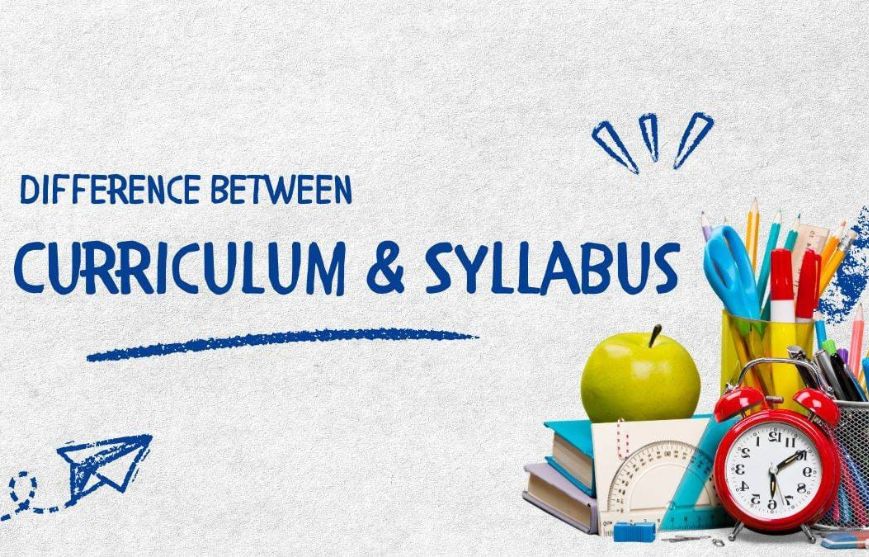-
Call: +91 80768 40282




School curriculum designing for an entire schooling level or preparing a course syllabus for a particular academic year will determine the future of education in the same way. Although, these two essential components of every educational program are the curriculum and syllabus, which are frequently used interchangeably.
There is a key distinction between curriculum and syllabus, though, in that the former is a specific document that offers comprehensive details about a single course within a program whereas, the latter is the larger, overarching framework that describes the educational objectives and structure of an entire program or institution. For more understanding walk through it. Let's begin the informational journey!
What Do You Understand By Curriculum?
The curriculum is the collection of rules designed to assist teachers in choosing the subject matter of a course. It is the study plan that outlines the course's goals, its contents, and its teaching strategies. Therefore, the curriculum will dictate why, what, and how should be taught.
Additionally, the curriculum enables teachers to use standardized assessments to gauge how well they are teaching. The management of a university or institute typically creates or curates the curriculum.
The curriculum's comprehensive structure serves as a multidisciplinary, grade-level, all-inclusive learning environment. More likely it's useful for:
Additionally, when disciplines are combined based on shared themes or abilities, coherence and continuity of learning can be guaranteed.
Understand: What is Syllabus?
The syllabus is a detailed list of subjects that will be studied with an overview of their subject matter. In contrast to lesson plans, curricula are created by teachers, also include outlines and condense the themes and topics that pupils will learn, and can be modified to meet the needs of a specific class.
Key Objectives of the Syllabus are as listed below:
Notedly, the syllabus is a component of the curriculum framework, which includes project specifics, exam dates, schedules, exams, projects, assignments, and assignment due dates.
schedules, exams, assignments, projects, and more are all included in a syllabus.
What’s The Difference?
Look at the table:
|
Criteria |
Curriculum |
Syllabus |
|
Definition |
The courses and materials that an educational institution offers are referred to as its curriculum. |
A syllabus is a detailed description of the topics that will be covered in a class. |
|
Scope |
There are several courses, subjects, and relationships across the entire educational curriculum. |
Whereas the syllabus concentrates on just one course or topic within the larger curriculum. |
|
Configuration |
difficult to modify |
simple to modify a syllabus to meet the needs of a class |
|
Content |
The course objectives, methods, and content are all included in the curriculum |
The syllabus includes information about assignments, tests, and other topics to address |
|
Term |
covers learning objectives and long-term educational goals over a long time frame, frequently years |
relates to short-term lesson programs, often lasting one semester or academic term. |
|
Example |
A K–12 curriculum lists the subjects (such as science and math) and learning objectives for each grade level. |
A college biology course syllabus outlines the subjects, assigned readings, homework, and evaluation procedures for that particular course. |
Curriculum & Syllabus Similarities:
Despite their differences, the curriculum and syllabus have certain things in common, as will be covered below.
The syllabus and curriculum are designed to make teaching and learning easier. They are created by professionals in the field to guarantee that the information fulfills learning goals and that students gain the required abilities.
The syllabus and curriculum provide teachers with a framework. While the syllabus gives specifics about what will be taught in each subject, the curriculum describes the overall educational program.
The two texts follow the rules and regulations of education. They support the organization of instructional strategies and content to improve the learning experiences of students.
The syllabus and curriculum are important tools for getting pupils ready for tests and assessments. They help students comprehend what they should study by outlining the course material.
The syllabus and curriculum are both essential to students' overall development. They include a variety of learning topics, such as social, emotional, and cognitive development.
Hence, Syllabus" and "curriculum" are frequently used interchangeably. However, The curriculum is the broad educational framework of an overall academic program, while the syllabus is a detailed course plan within that framework.
Conclusion:
In conclusion, the total strategy and structure for teaching a subject, comprising learning goals, teaching strategies, and evaluation procedures, is known as the curriculum. The syllabus, on the other hand, is a detailed document that lists the material that will be studied in a given course along with other crucial details like class scheduling and grading guidelines.
Moreover, they all allude to different facets of a course of study. Both teachers and students must comprehend the distinctions between these two ideas. It aids in making sure that learning objectives are accomplished and that learning outcomes are precisely stated and attained. Furthermore, distinguishing these two helps educators in the creation of effective teaching strategies, and at the same time, enables students to navigate their academic journey.